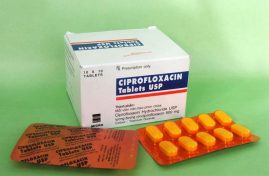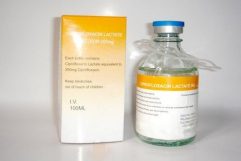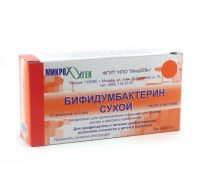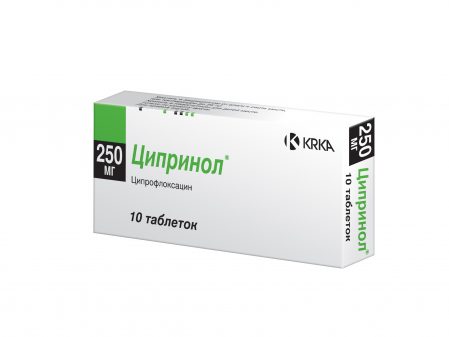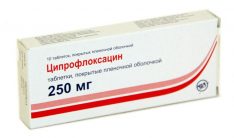Ciprofloxacin is a universal medicine with antibiotic effect. It is used in various fields of medicine with one goal - to destroy the pathogenic microflora inside the body and accelerate the patient’s recovery. In order for the medicine to work effectively and not cause side effects, you must strictly follow the instructions for its use.
Material Content:
Form of release and composition of the drug
The antibiotic is available in different forms, each of which has its own nuances and recommendations for use. They are united by one thing - composition. The basis of the drug is a chemically synthesized substance with antimicrobial activity, ciprofloxacin. It gave the name to the drug itself.
Usually, doctors prescribe one of the three main forms of release.
Eye and ear drops
This is a liquid medicine format for local use. Eye and ear drops contain ciprofloxacin in the form of hydrochloride. Its concentration is 3 mg / ml. As additional ingredients, chemical compounds standard for this form of release are used - purified water, saline, Trilon B.
Drops are prescribed to quickly eliminate bacteria in the mucous membranes of the eyes or in the ear canals. In addition, doctors can prescribe another option for topical use - an eye ointment, which contains an antibiotic and is placed under the lower eyelid for a better fight against microbes.
Infusion solution
The second form of production is a liquid solution. Ciprofloxacin injections are not given.In cases where it is necessary to urgently help the patient, the medicine is administered intravenously. The active substance instantly enters the bloodstream and goes to the focus of inflammation.
The concentration of the antibiotic in the solution for injection is 2 mg / ml. As additional ingredients, water, low concentration hydrochloric acid, lactic acid, saline are used.
Pills
The antibiotic "Ciprofloxacin" in the form of dragees is intended for oral administration. In this case, the active component will be absorbed through the villi of the gastrointestinal tract and with the flow of blood will be distributed throughout the tissues. The concentration of the active substance may be different. 250 mg, 500 mg and 750 mg tablets are available. In addition to the antibiotic itself, each dragee contains a number of auxiliary components - starch, talc, silica, macrogol, various additives.
All forms of the drug are designed to destroy colonies of bacteria that form when weakened immunity in the internal environment of the body. The medicine, like all fluoroquinolones, is considered an antibiotic of the first generation. It quickly spreads to the tissues and penetrates the cells. The drug works by blocking the bacterial enzyme, DNA gyrase. As a result, the transmission of genetic information during reproduction is disrupted in microbes, as a result of which the entire colony dies.
On a note. It is Ciprofloxacin and other drugs based on this substance that are most often prescribed to patients with bacterial infections. This is due to the fact that most pathogenic microorganisms are sensitive to the drug, and resistance to it is formed slowly.
Instructions for use Ciprofloxacin, dosage for adults and children
The drug is always prescribed only by a specialist. Doctors inform patients about all the nuances of using the antibiotic in the treatment of infections.
The daily dose of tablets usually varies from 500 mg to 1.5 g, depending on the intensity of the symptoms. Take the drug twice a day at approximately the same intervals. This is important, because it is required throughout the course of treatment to maintain a stable concentration of the antibiotic in the blood.
Doctors also give more accurate daily amounts of medicine for various diseases:
- cystitis - 500 mg;
- genital tract infections - 2x250 or 2x500 mg;
- respiratory diseases - 2x500 or 2x750 mg;
- prevention of meningitis - 500 mg;
- peritonitis - 2x750 mg;
- anthrax - 2x500 mg.
Usually, doctors prescribe 500 mg Ciprofloxacin tablets. This is the most preferred format for most diseases.
The solution for infusion is also used strictly according to the instructions. The antibiotic is administered intravenously with a dropper. The standard dose for an adult is 200 - 800 mg per day. Procedures are carried out daily for a week.
Ciprofloxacin eye drops are commonly used in the treatment of ulcerative keratitis.
The scheme is as follows:
- 1 day: 2 drops of an antibiotic with an interval of 15 minutes (for 6 hours);
- 2 day: 2 drops with an interval of 1 hour;
- 3 and subsequent days: 2 drops at intervals of 2 hours.
The total duration of treatment will be from 7 to 14 days, depending on the speed of recovery.
The drug can also be used to treat inflammation of the hearing organs. With otitis media provoked by bacteria, 4 drops are dropped into each ear canal twice a day.
Important! Do not use cold medicine. Immediately before use, warm the solution in your palms at least to room temperature.
During pregnancy and lactation
Pregnant women are forced to select medicines especially carefully, since many drugs have teratogenic effects. In other words, their uncontrolled use leads to fetal malformations, which should not be allowed.
Doctors advise to abandon the internal intake of the antibiotic during the bearing of the child, since there is no exact data on the possible effect of the drug on the fetus. Local forms can be used in minimal quantities after consultation with a doctor.
For the treatment of bacterial infections with lactation, you should also choose a different drug, since ciprofloxacin passes into breast milk and enters the baby's body. An alternative is antibiotic therapy and a temporary cessation of lactation.
Drug Interactions with Other Drugs
The patient should inform the doctor who prescribes the antibiotic about taking any other medicines. This is to avoid possible unwanted interactions. For example, do not combine ciprofloxacin with antacids that affect the acidity inside the digestive tract. When combined, the antibiotic is too slowly absorbed into the bloodstream and becomes ineffective.
In addition, it is undesirable to combine the medicine with Probenecid because of the risk of removing the spent active substance from the body too slowly. A similar situation is observed when combined with Theophylline.
Contraindications, side effects and overdose
The medication is effective against a number of pathogenic bacteria, however, it can not be prescribed always. There are situations in which reception is not possible.
These included:
- pregnancy;
- lactation;
- drug intolerance;
- liver dysfunction;
- severe kidney damage.
It is important to pay attention to the age limit. The drug is used to treat adult patients and adolescents. Drops are allowed only from 15 years old, and droppers and tablets from 12 years old.
Antibiotics often provoke side effects. The most common phenomenon that occurs during therapy is dysbiosis. The reasons for this condition lie in the fact that the drug does not have selectivity of action. It totally destroys the entire microflora, including beneficial microbes that live in the intestines.
With their shortage, a person begins to suffer from typical symptoms, such as:
- alternating diarrhea and constipation;
- bloating;
- severity
- increased gas formation;
- pallor of the skin;
- the appearance of a rash;
- loss of appetite.
It is possible to prevent the development of dysbiosis during treatment with antibiotics if you take probiotics in parallel with them to normalize the intestinal microflora - “Acipol”, “Bifidumbacterin”, “Linex”.
Other side effects of using the medicine include:
- dizziness;
- fast fatiguability;
- weakness;
- tremor.
Allergic reactions occur rarely. Usually they develop if the dosage recommended by the doctor is significantly exceeded.
In this case, the following can be observed:
- edema;
- itching of the skin;
- rash;
- redness of the skin.
With intensely pronounced signs of an overdose, the patient is shown gastric lavage, since there is no specific antidote to the antimicrobial agent.
Ciprofloxacin Analogs
Doctors prescribing this medicine clarify that the patient can purchase a drug with the same substance in the composition, but produced under a different brand. These are the so-called generics - medicines with an absolutely identical mechanism of action.
These include:
- Ciprinol;
- Ififpro;
- "Ecocifol";
- Basidzhen;
- Tsiprodoks.
Other antibiotics are sometimes used, with a composition different from that of Ciprofloxacin. This is necessary if during the examination of the patient revealed that the existing strain of microorganisms is resistant to this drug.
- Amoxicillin. It is an inexpensive but effective antibiotic that is often prescribed for respiratory infections. It can also be used to treat cystitis, pyelonephritis. Its absolute advantage is the possibility of use in childhood.
- "Nolicin." In its effect, this antibiotic closely resembles Ciprofloxacin.In its composition - norfloxacin, which quickly destroys pathogenic microorganisms. This medicine is prescribed less often, as it has an extended list of contraindications and side effects. It should not be given to children and adolescents under 18 years of age.
- "Chloramphenicol." This chemical compound can be part of tablets, a solution for infusion, but most often it is used as drops for the eyes. It is it that is included in the composition of Chloramphenicol, which quickly fights inflammation on the conjunctiva, cornea, and ciliary edge. Drops, if indicated, are allowed even to infants.
The decision on the appointment of a particular antibiotic is always made by the doctor. Initially, a full examination of the patient is carried out in order to identify the type of microorganisms that provoke inflammation, and their strain. Only after receiving the results of the analyzes, experts prescribe Ciprofloxacin or its analogue, which is more effective in a specific situation.



